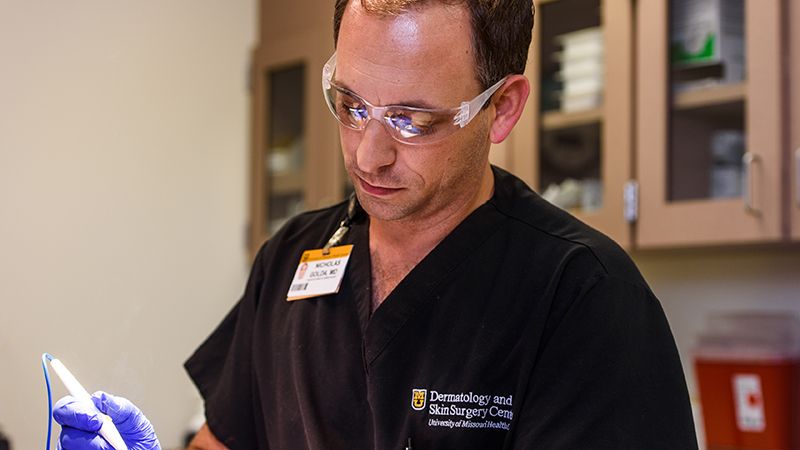
As health care costs continue to rise, researchers from the University of Missouri School of Medicine are working to better understand how patients assign value to the cosmetic outcomes of medically necessary skin cancer procedures.
Their recent findings illustrate how skin cancer patients’ surgical preferences depend on the tumor location and risk of cancer recurrence. The researchers discovered patients who required skin cancer surgery on their faces were willing to pay the most for a smaller scar.
“In the era of high-deductible plans, the out-of-pocket expenses are going to be quite a bit more,” said Nicholas Golda, MD, former associate professor of dermatology at the University of Missouri School of Medicine. “Patients have an increasing responsibility for their health care costs, and we’re trying to find out what patients value most.”
Researchers conducted a multisite study of 912 skin cancer patients. Participants were randomly assigned to one of four scenarios: skin cancer on the cheek or back with a low risk of spreading or skin cancer on the cheek or back with a high risk of spreading.
The researchers found patients desired smaller and barely visible scars. In addition, the patient’s willingness to pay for a smaller or less noticeable scar was higher when the surgery affected the face rather than the back.
Because scar size and appearance are related to initial tumor size, using tissue-sparing techniques – such as Mohs micrographic surgery – to treat skin cancer is one way to achieve a patient’s desire for a smaller and less noticeable scar, Golda said.
“We make smaller holes with Mohs surgery,” Golda said. “The idea is that Mohs would yield a smaller defect and provide an opportunity for a smaller scar. With Mohs, you are doing all of the laboratory work, the examination and the excision all bundled into the same procedure. Per incidence, it seems costly, but when you start looking at recurrence rates and the cost of doing subsequent surgeries to treat recurrence – and the opportunity for smaller reconstructions on a population level – cost levels out.”
Golda’s findings also revealed patients were willing to pay twice as much for a 1-inch scar on the face or back instead of a 5-inch scar. However, they were only willing to pay half as much for a 1-inch scar on the back compared to the same-sized scar on the face.
“As medicine zeroes in on being patient-centered, our decisions must reflect patient preferences,” Golda said. “What has value and what doesn’t have value? Essentially, how would people like to be treated?”
In addition to Golda, the study authors include William Black, MD, Department of Dermatology, University of Mississippi; Visal Patel, MD, Department of Dermatology, George Washington University School of Medicine; Donald Neal, BA, The Thomas Jefferson University Sidney Kimmel Medical College; and Jeremy Etzkorn, MD, Department of Dermatology, The University of Pennsylvania Perelman School of Medicine
The study, “Determining patient preferences and willingness to pay related to scar length and appearance following skin cancer treatment on the face and trunk: A multi-center discrete choice experiment,” was recently published in the Journal of the American Academy of Dermatology. Research reported in this publication was supported by a 2017 Cutting Edge Research Grant from the American Society for Dermatologic Surgery. Etzkorn is supported by a Dermatology Foundation Career Development Award in Dermatologic Surgery. The content is solely the responsibility of the authors and does not necessarily represent the official views of the funding agencies.





